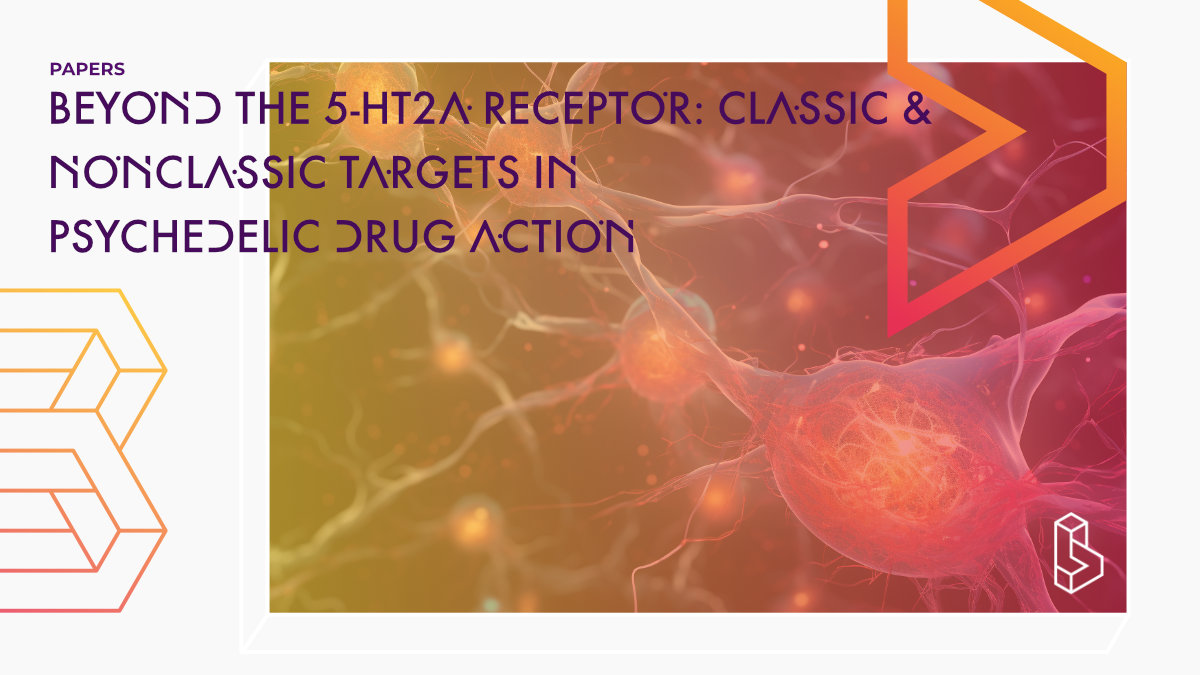This mini-review (2023) provides insights into the complex mechanisms of action of serotonergic psychedelics, such as psilocybin and LSD, emphasizing their activation of serotonin receptors, particularly 5-HT2A receptors, leading to alterations in perception, cognition, and emotions. The review explores the role of neuroplasticity in their therapeutic potential for mental health conditions and discusses interactions with other serotonin receptor subtypes and neurotrophin receptors. Additionally, it highlights the emerging interest in developing non-hallucinogenic derivatives to retain therapeutic benefits while minimizing the risk of adverse reactions and explores the potential of psychedelics in post-translational modification of proteins as part of their mechanism of action.
Abstract of Beyond the 5-HT2A Receptor: Classic and Nonclassic Targets in Psychedelic Drug Action
“Serotonergic psychedelics, such as psilocybin and LSD, have garnered significant attention in recent years for their potential therapeutic effects and unique mechanisms of action. These compounds exert their primary effects through activating serotonin 5-HT2A receptors, found predominantly in cortical regions. By interacting with these receptors, serotonergic psychedelics induce alterations in perception, cognition, and emotions, leading to the characteristic psychedelic experience. One of the most crucial aspects of serotonergic psychedelics is their ability to promote neuroplasticity, the formation of new neural connections, and rewire neuronal networks. This neuroplasticity is believed to underlie their therapeutic potential for various mental health conditions, including depression, anxiety, and substance use disorders. In this mini-review, we will discuss how the 5-HT2A receptor activation is just one facet of the complex mechanisms of action of serotonergic psychedelics. They also interact with other serotonin receptor subtypes, such as 5-HT1A and 5-HT2C receptors, and with neurotrophin receptors (e.g., tropomyosin receptor kinase B). These interactions contribute to the complexity of their effects on perception, mood, and cognition. Moreover, as psychedelic research advances, there is an increasing interest in developing nonhallucinogenic derivatives of these drugs to create safer and more targeted medications for psychiatric disorders by removing the hallucinogenic properties while retaining the potential therapeutic benefits. These nonhallucinogenic derivatives would offer patients therapeutic advantages without the intense psychedelic experience, potentially reducing the risks of adverse reactions. Finally, we discuss the potential of psychedelics as substrates for post-translational modification of proteins as part of their mechanism of action.”
Authors: Lindsay P. Cameron, Joseph Benetatos, Vern Lewis, Emma M. Bonniwell, Alaina M. Jaster, Rafael Moliner, Eero Castrén, John D. McCorvy, Mikael Palner & Argel Aguilar-Valles
Summary of Beyond the 5-HT2A Receptor: Classic and Nonclassic Targets in Psychedelic Drug Action
Introduction
Serotonergic psychedelics are gaining rapid support because of their fast-acting therapeutic effects for a variety of neuropsychiatric conditions. They target many 5-HT receptors and interact with multiple other neurotransmitter systems.
LSD, an indolamine-based psychedelic, appears to exert its effects through 5-HT1A agonism in concert with 5-HT2A, while the phenethylamines (e.g., mescaline) show no affinity for 5-HT1A. Thus, a more rigorous description of the molecular pathways is needed to disentangle the therapeutic action from the various hallucinogenic effects.
Find this paper
Beyond the 5-HT2A Receptor: Classic and Nonclassic Targets in Psychedelic Drug Action
https://doi.org/10.1523/JNEUROSCI.1384-23.2023
Paywall | Google Scholar | Backup | 🕊
Cite this paper (APA)
Cameron, L. P., Benetatos, J., Lewis, V., Bonniwell, E. M., Jaster, A. M., Moliner, R., ... & Aguilar-Valles, A. (2023). Beyond the 5-HT2A Receptor: Classic and Nonclassic Targets in Psychedelic Drug Action. Journal of Neuroscience, 43(45), 7472-7482.
Study details
Compounds studied
LSD
Psilocybin
Topics studied
Neuroscience
Study characteristics
Literature Review

